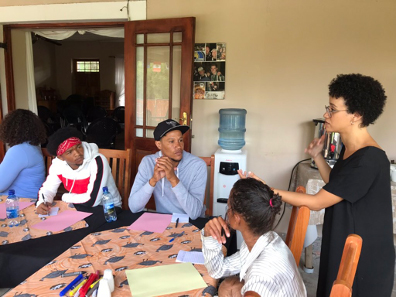Sustained Dialogues Programme – April 2020 News

IJR’s Danielle Hoffmeester talks to participants in Calitzdorp
’With these hands, we will rebuild our communities!’’ proclaimed Calitzdorp youth – fitting commitment by young people and elders alike, to rebuild, restore and plough back into our communities.
Our individual and collective histories as well as our present-day realities tell us that young people here and across the globe possess the talent, ethos, creativity, innovation and resilience required to transform radically our-inner-selves, for the future wellbeing of our communities and our environment. An inspiring call to action set the tone with which we ended the 3-day community dialogues, just days before social distancing and isolation.
It is during this time of slowing down, that some of us now have the privilege of stillness and deep inward reflection about our roles as change agents who remain committed to social justice.
I reflect on the overwhelming state of perpetual inequality and inherited systems of violence that impede our collective ability to build resilience in face of crisis and disease. I reflect on the colossal task ahead, for younger generations, not only to dismantle these systems but also to rebuild and to construct fairer, more just, more sustainable and more equitable ones.
But how do we do that? How do we harness our strengths and power to do so? These are critical questions that remained central to our discussions with the group of young people in Calitzdorp who have also been grappling with questions about identity, belonging, human dignity, creative self-expression, fostering inner peace, mental and emotional health and the importance of practising compassion and empathy as radical tools for social justice.
It is with this spirit that youth in Calitzdorp are creating their own ways and spaces for young people and children in their community to explore their passions, talents and self-expression while reclaiming space, voice and future. They do this through dance groups, soccer teams and tournaments and a newly created LGBTQIA+ safe space for young Queer people. This is particularly significant in a small semi-rural town like Calitzdorp that closely resembles other parts of South Africa, where government-created opportunities for young people remain dismal. Yet here we see young people mobilising outside of the status quo, building movements for social change and justice, with their bare hands, from the ground up, with little to no resources and support.
By no means is this an attempt to romanticise this struggle. We reserve the hard-fought right to live in a country and exist in a society that deliberately invests in the development and wellbeing of children and youth. A society where educational and recreational opportunities as well as creative arts programs are available to young people on community level. We reserve the right to be the captains of our own destinies and to live dignified lives in communities where we are all safe and where we all can flourish. Instead my intention here is to simply share these stories of change, to aid us in our moments of reflection and perhaps even inspire hope that change is possible and that we all have a part to play.
Spaces for community dialogues continue to echo the importance of centralising the voices, lived realities and experiences of black and coloured youth within our social justice and dialogue praxis.
This generation of young people exists in a time of global crisis, socioeconomic vulnerability, racialised and gendered inequality, poverty, unemployment, active conflict and gender-based violence and hate crime. This generation is grappling with inherited trauma, the legacies of our past and the systems of oppression that continue to suffocate us. This generation is beginning to experience the direct consequences of continued environmental degradation, global warming and an inhumane capitalist global order. These are major challenges, deep wounds and divisions that we will have to face as we take up leadership in our communities, in our movements for change, in our faith-based communities, in the education sector, in the business sector, in government, in the arts sector, the civil society sector, and all other spheres of society. These experiences, these nuances and these lessons learnt ought to inform how it is we will respond, how it is that we will rebuild and reconstruct in the years to come.
In times of crisis, it is the most vulnerable of us who are disproportionately affected. This will have to be a critical consideration for our vehicles of change. How can we better support each other, in times of community action and now? How can we ensure our collective and individual wellbeing? How can we build on our inner resilience during this time? How can we better support young people in their roles as community builders, community leaders and community healers? How can we foster greater solidarity? How can we support local artists and art as a tool for community healing and dialogue? How do we step into our power, reclaim our agency and continue the hard work for the various communities we represent? To create safe spaces for the most vulnerable? To collaborate and work together? To fight for structural and transformative change?
Young people have historically and continued to show utmost commitment to transforming social and political norms that are unjust while creating space for deliberate action and change. We have seen this revolution unfold before, in the hearts and minds of South African youth. I am certain that the work will continue to be done and we all have a role to play. The challenge now to you is, what’s yours?
A luta continua!
